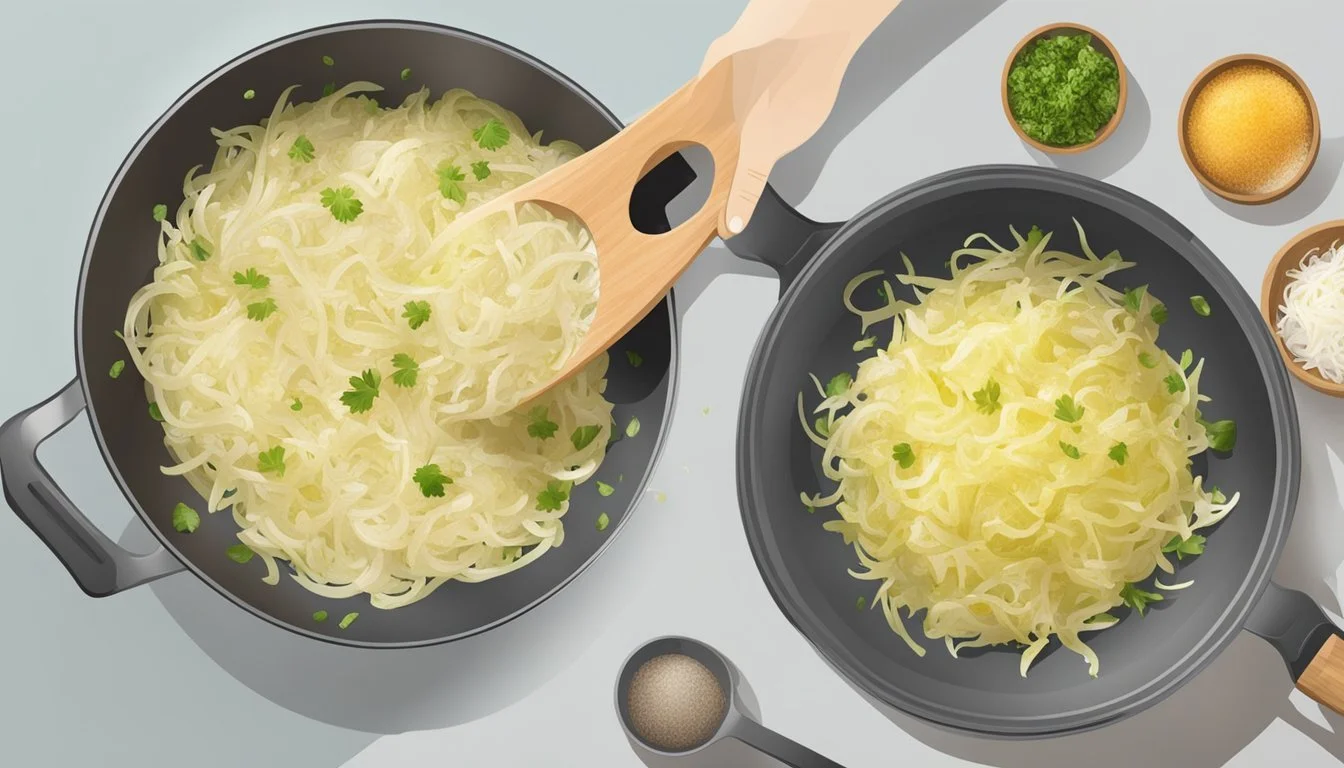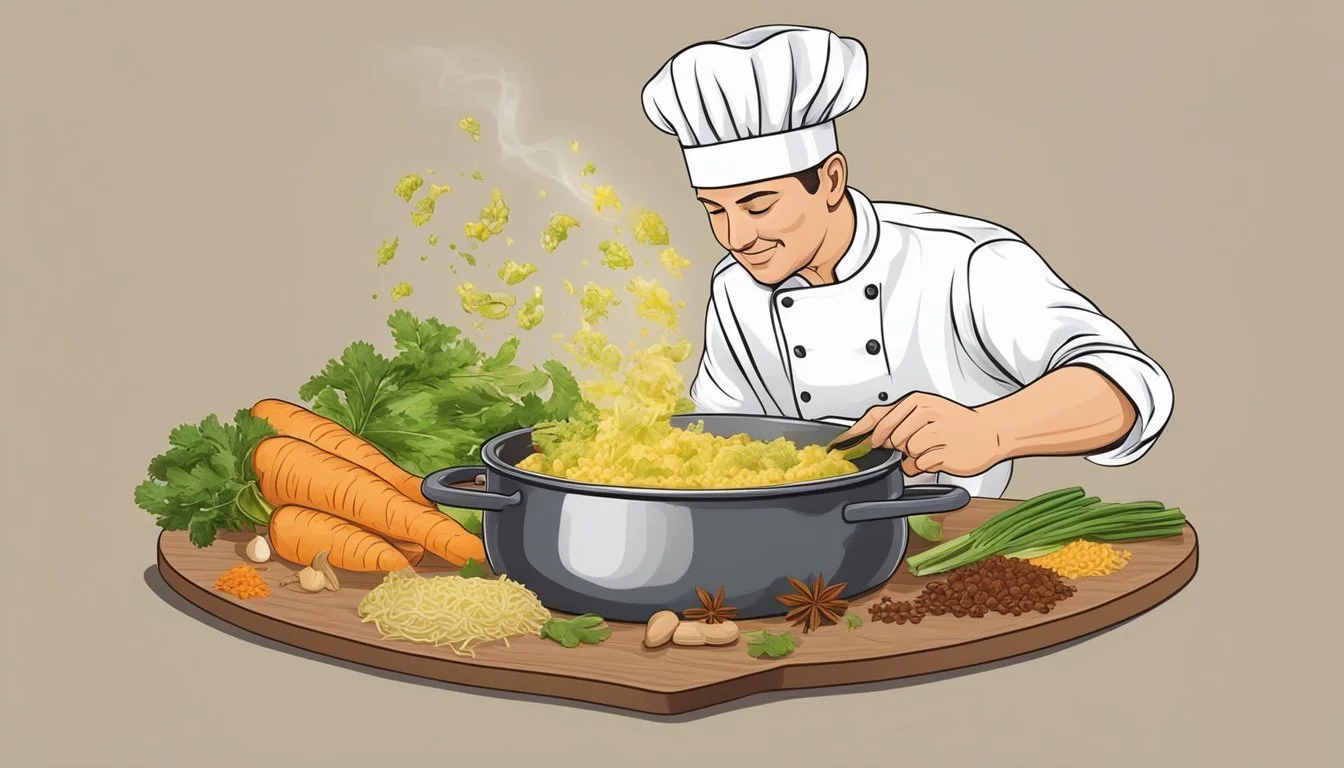Canned Sauerkraut Recipes for German Cuisine
Classic and Creative Dishes
Sauerkraut, the fermented form of cabbage, is not only a staple in German cuisine (What Wine Pairs Perfectly With German Cuisine) but also valued for its tangy flavor and potential health benefits. This traditional dish results from a fermentation process that naturally preserves the cabbage through lactic acid bacteria, creating a distinctively tangy side that complements a variety of meats and dishes in German cooking. Rich in vitamins and probiotics, sauerkraut has been linked to improved digestion and immune function, making it both a flavorful and beneficial addition to meals.
With convenience in mind, canned sauerkraut brings this traditional German ingredient to modern kitchens with ease. While some purists advocate for homemade sauerkraut due to its fresh and vibrant taste, canned versions provide a quick alternative that requires minimal preparation. The challenge then becomes transforming this humble pantry item into a dish that resonates with the depth of flavor found in classic German recipes.
Through skillful seasoning and cooking techniques, chefs and home cooks alike can elevate canned sauerkraut to new culinary heights. Incorporating ingredients like apple, onion, garlic, and various spices, one can create sauerkraut dishes that marry the convenience of canned goods with the authenticity of German flavors. This approach to sauerkraut prepares the palate for a tour through Germany's gastronomic heritage without ever leaving the comfort of one's kitchen.
Health Benefits of Sauerkraut
Sauerkraut, a traditional fermented cabbage dish, is not only a staple in German cuisine but also a powerhouse of nutritional value. It's low in calories yet rich in fiber, contributing to better digestion and regularity. The fermentation process produces probiotics, live bacteria beneficial for gut health.
Vitamins are abundant in sauerkraut, particularly Vitamin C and Vitamin K. Vitamin C is crucial for immune function and skin health, while Vitamin K plays a key role in bone health and blood clotting.
Nutrient Benefit Fiber Aids in digestion Probiotics Enhances gut health Vitamin C Supports immune system Vitamin K Essential for bone and blood health
Regarding health benefits, sauerkraut's probiotics are key. They can help balance the gut microbiome, which is vital for overall health. Although the heat treatment in canning might reduce these probiotics, the remaining vitamins and minerals still contribute to a balanced diet.
Vitamin C in sauerkraut also acts as an antioxidant, helping to neutralize free radicals that may contribute to inflammation and disease. On the other hand, Vitamin K is less well-known but equally significant, associated with cardiovascular health and bone density.
Incorporating sauerkraut into one’s diet can result in a range of benefits from the nutrients it provides. However, it is important to note that while canned sauerkraut still retains its nutritional value, for optimum probiotic benefits, one might consider consuming fresh or refrigerated varieties.
How to Cook Canned Sauerkraut
Canned sauerkraut is a versatile ingredient that can be easily prepared to complement a variety of German dishes. By following simple cooking techniques using a stove, oven, or microwave, one can enhance the flavor and serve it as a delightful side.
On the Stove
To cook canned sauerkraut on the stove, one should first drain and rinse it to remove excess brine and adjust the saltiness. It is then heated in a saucepan with a little water, butter, or stock for added flavor. On medium heat, one brings the sauerkraut to a simmer and cooks it for 10-15 minutes.
Ingredients: Canned sauerkraut, butter or oil, water or stock
Steps:
Drain and rinse the sauerkraut.
Melt butter in a pan over medium heat.
Add sauerkraut and liquid (water, chicken stock).
Simmer for 10-15 minutes, stirring occasionally.
In the Oven
For those who prefer the oven method, one can bake canned sauerkraut after it has been drained and rinsed. Place it in a baking dish with a splash of liquid, such as apple juice or white wine, and optional seasonings. Cover with foil and bake at 350°F for about 20 minutes or until it is hot throughout.
Ingredients: Canned sauerkraut, apple juice or white wine, seasonings
Steps:
Preheat the oven to 350°F (175°C).
Combine the sauerkraut with liquid and seasonings in a baking dish.
Cover with foil and bake for about 20 minutes.
Using a Microwave
For a quicker option, one can use a microwave to cook canned sauerkraut. After draining and rinsing, place the sauerkraut in a microwave-safe bowl with a little water or stock. Cover it and microwave on high for about 4-5 minutes or until it's thoroughly heated.
Ingredients: Canned sauerkraut, water or stock
Steps:
Drain and rinse the sauerkraut.
Combine sauerkraut with a little liquid in a microwave-safe bowl.
Cover and microwave on high for 4-5 minutes.
Classic German Sauerkraut Recipes
German sauerkraut recipes are cherished for their simplicity and depth of flavor. Traditional methods combine sauerkraut with various ingredients to achieve a savory, tangy taste that's deeply rooted in German culinary traditions.
Bavarian Sauerkraut
In Bavaria, sauerkraut is cooked with a rich blend of ingredients that elevate its natural flavors. Here's a brief recipe outline:
Start by melting butter in a pan, then sauté onion and garlic until translucent.
Add the sauerkraut, along with a brine of chicken stock or apple juice to enhance moisture and taste.
To create the distinct Bavarian flavor, incorporate juniper berries, a bay leaf, and a small amount of brown sugar for balance.
Allow the mixture to simmer gently, letting the flavors meld together harmoniously.
Here is a structured table of ingredients for Bavarian Sauerkraut:
Ingredient Quantity Notes Butter 2 tablespoons Onion 1, finely diced Garlic 2 cloves, minced Optional Sauerkraut 1 can (drained) Chicken stock 1 cup Or apple juice Juniper berries 4-5 Brown sugar 1 teaspoon Adjust to taste Bay leaf 1
Cook this on low heat for about 20-30 minutes, stirring occasionally, until the flavors are well incorporated and the sauerkraut is tender.
Reuben Sandwich
A Reuben Sandwich is a classic deli staple with German-American roots. For the sauerkraut component, chefs typically:
Drain the canned sauerkraut to remove excess moisture.
Sauté the sauerkraut on medium heat to warm and slightly caramelize it, enhancing its flavor profile.
Season the sauerkraut with black pepper and, if desired, caraway seeds for an extra layer of taste.
This sautéed sauerkraut is then layered between slices of rye bread with Swiss cheese, corned beef, and Russian dressing to compose the Reuben sandwich.
The table below lists the key ingredients for a Reuben Sandwich with a focus on the sauerkraut:
Ingredient Quantity Notes Sauerkraut 1/2 cup Drained and sautéed Rye bread 2 slices Swiss cheese 2 slices Corned beef 4 oz Russian dressing 2 tablespoons Caraway seeds 1/2 teaspoon Optional
To assemble, the sandwich is grilled until the cheese melts and the bread is toasted to a golden brown, creating a melange of textures and tastes.
Innovative Sauerkraut Dishes
German cuisine offers a wealth of hearty and flavorful dishes that incorporate sauerkraut. Among these, sauerkraut casserole, soup, and German potato salad stand out for their unique twists on traditional flavors. Each dish is easy to make and serves as a perfect side dish or a main course.
Sauerkraut Casserole
Sauerkraut casserole presents a comforting and richly flavored dish, combining sauerkraut with layers of tender meats and potatoes. (What wine goes well with potatoes?) To prepare, one arranges layers of sauerkraut, diced potatoes, onions, (What wine goes well with onions?) and cooked bacon or sausage in a casserole dish. The mixture is then seasoned with caraway seeds and black pepper, moistened with chicken stock or white wine, and baked until golden and bubbly. This dish is a unique and hearty option that embodies the spirit of German comfort food.
Sauerkraut Soup
For a warming meal, sauerkraut soup features the fermented cabbage in a savory broth, often enriched with pork, potatoes, and beans. It begins with sautéed onions and garlic, to which sauerkraut, diced potatoes, sliced carrots, and chunks of smoked sausage are added. The ingredients are simmered in a rich stock until everything melds together into a flavorful and hearty soup that is both nourishing and easy to prepare.
German Potato Salad
German potato salad is a classic side dish that offers a tangy alternative to its creamy American counterpart. The key ingredients include boiled potatoes, finely chopped onions, and generous amounts of sauerkraut. These are tossed with a warm dressing made from vinegar, mustard, and a sweetener like sugar or apple juice to balance the sauerkraut's tartness. Finished with fresh herbs like parsley, this German potato salad is a zesty, flavorful, and easy-to-make accompaniment to any meal.
Cooking Techniques and Tips
Preparing canned sauerkraut for a German cuisine dish requires careful attention to both balancing flavors and achieving the right texture. Through meticulous seasoning and proper cooking methods, one can elevate the humble canned sauerkraut into a delightful component of any meal.
Balancing Flavors
To create a flavorful experience, it's crucial to balance the tanginess of sauerkraut with complementary tastes. One may begin by sautéing aromatic ingredients like onions and apples to introduce sweetness and depth. A dash of brown sugar can further counteract the sourness, creating a well-rounded flavor profile.
Seasoning Mixture:
Salt: Add to taste, enhancing all other flavors.
Caraway Seeds: A pinch not only adds authenticity but also gives a slight anise-like flavor.
Black Pepper: Freshly ground to bring a mild heat.
Sugar: Can be used in the form of brown sugar to add a subtle molasses sweetness.
In addition, incorporating carrots can add both sweetness and an extra layer of texture. They should incorporate these ingredients gradually and taste as they go, ensuring that no single flavor overwhelms the dish.
Achieving the Perfect Texture
The desired texture for sauerkraut is typically tender but not mushy. To accomplish this, they must first drain the sauerkraut to remove excess liquid. Then, one might choose a cooking liquid such as chicken stock or white wine to simmer the sauerkraut. This process should be done on low heat to allow flavors to meld without overcooking.
Cooking Steps:
Drain the Sauerkraut: To remove excess brine.
Simmer: In a flavorful liquid like chicken stock or white wine.
Stir Occasionally: To ensure even cooking and prevent sticking.
Watch the Clock: About 10-15 minutes of simmering usually suffices.
For a creamy finish, they could opt to stir in a touch of cream towards the end of cooking. This addition should be done sparingly to enrich the sauerkraut without making it overly heavy.
Pairing Sauerkraut With Proteins
Pairing sauerkraut with proteins can provide a balance of flavors and textures that are essential in German cuisine. Sauerkraut's tangy taste enhances the richness of meats and can be a fresh counterpoint to vegan alternatives.
With Pork Chops
When serving pork chops, (What wine goes well with pork chops?) sauerkraut can act as an appetizing side or topping. The acidity of sauerkraut cuts through the fat of the pork, offering a palate-cleansing effect. For a traditional approach, one can simply top the grilled chops with sauerkraut that has been warmed and seasoned with caraway seeds and a dash of apple juice to mellow the flavor.
Kielbasa and Sauerkraut
Kielbasa, a type of Polish sausage, pairs naturally with sauerkraut. For a hearty meal, the sausage can be slowly simmered in a pot with sauerkraut, apple slices, and a hint of brown sugar. Smoked sausage, similar to kielbasa, also complements the sour notes of sauerkraut. Incorporating bacon pieces can add a smoky depth that marries well with the sauerkraut's profile.
Vegan Alternatives
Vegan alternatives to traditional sausages can be prepared with sauerkraut to serve a plant-based audience without sacrificing flavor. Tofu or seitan (What wine goes well with seitan?) can be seasoned with savory herbs and combined with sauerkraut that's been cooked with a splash of white wine and peppercorns. The use of smoked paprika and fennel seeds in the preparation of vegan proteins can mirror the essence of smoked meats (What wine goes well with smoked meats?) traditionally served with sauerkraut.
Accompaniments and Sides
When incorporating canned sauerkraut into German cuisine, understanding the perfect pairings can amplify the flavors of your dish. Traditionally, sauerkraut—or sour cabbage—is a staple in German meals and harmonizes well with a variety of accompaniments:
Classic Companions
Boiled Potatoes: A simple yet classic side, boiled potatoes offer a mild flavor that complements the tanginess of sauerkraut.
German Red Cabbage (Rotkraut): This colorful side adds sweetness to the plate, balancing the sour notes of sauerkraut.
Meaty Pairings
Pork Roast: The rich fattiness of a pork roast cuts through the acidity of sauerkraut.
Sausages: A selection of German sausages like Bratwurst brings hearty and savory flavors to the meal.
Bread-Based Sides
Bread Dumplings: They act as sponges, soaking up the sauerkraut juices and enhancing the overall experience.
Pretzels: Warm, salted pretzels offer a chewy texture and saltiness which can offset the sharpness of sauerkraut.
Beverage Pairing
White Wine: A dry Riesling or another crisp white wine can cleanse the palate between bites of sauerkraut and its rich sides.
Side Dish Description Boiled Potatoes Mild and soft; balances sauerkraut's acidity. Red Cabbage Adds a sweet counterpoint to the sauerkraut. Pork Roast The richness tempers the tangy cabbage. Sausages Brings a savory, spiced dimension to the meal. Bread Dumplings Soft dumplings that absorb the flavorful juices of the sauerkraut. Pretzels Saltiness and chewiness provide a satisfying contrast. White Wine (Dry) Refreshing and palate-cleansing; complements the sauerkraut without overpowering it.
Pairing sauerkraut with appropriate sides ensures a well-rounded and enjoyable German culinary experience.
Preserving and Storing Sauerkraut
When it comes to preserving and storing sauerkraut, whether it is homemade or canned, maintaining its shelf life and flavor is crucial. For homemade sauerkraut, a fermentation crock is traditionally used. The crock should be filled with fresh sauerkraut and submerged in brine, which is a saltwater solution critical to the fermentation process. Bay leaves and black peppercorns can be added to the crock to infuse additional flavors.
Once fermentation is complete:
Transfer the sauerkraut to glass jars, ensuring they are clean and sterilized.
Pour in enough brine to cover the sauerkraut.
Seal the jars tightly and store in a cool, dark place for long-term keeping.
For freezing homemade or canned sauerkraut:
Pack sauerkraut into suitable containers, leaving enough headspace for expansion.
Seal the containers to prevent freezer burn.
Storing canned sauerkraut is simpler since it has already been preserved:
Keep it in a cool, dry place until opened.
After opening, refrigerate the remaining sauerkraut in a covered container and consume it within a few days.
By following these methods, sauerkraut can be safely stored while retaining its distinctive tartness and probiotic benefits. Always ensure sauerkraut is fully submerged in brine within containers to prevent mold and spoilage.
Converting Canned to Gourmet
Transforming canned sauerkraut into a gourmet dish is an easy process that can significantly enhance its flavor. To start, chefs recommend rinsing the sauerkraut to remove the excess brine, which can be overly salty.
Ingredients:
1 can sauerkraut, drained and rinsed
2 tablespoons unsalted butter or olive oil
1/2 onion, finely diced
1 cup chicken stock or vegetable broth
Seasonings: caraway seeds, black pepper, and bay leaf
Method:
Prepare the Base: Begin by sautéing the onions in butter or olive oil in a skillet until translucent. This creates a flavorful foundation.
Add Depth: Incorporate the sauerkraut, stirring well with the onions to combine. Then, pour in chicken stock or vegetable broth, which should not only moisten but also infuse the sauerkraut with a rich, savory flavor.
Season Generously: For a traditional touch, sprinkle some caraway seeds and a pinch of black pepper. Caraway seeds offer an aromatic hint that's characteristic of German cuisine.
Optional Sweetness: While some recipes call for granulated sugar, an alternative for a more nuanced sweetness is a small amount of maple syrup.
Simmer: Allow the mixture to simmer gently, preferably covered, for at least 20 minutes. The sauerkraut will soften and absorb the flavors, melding everything into a cohesive and gourmet side dish suitable for pairing with various German entrees.
By incorporating these steps, canned sauerkraut is elevated from a simple pantry staple into a refined and delectable component of any meal.









